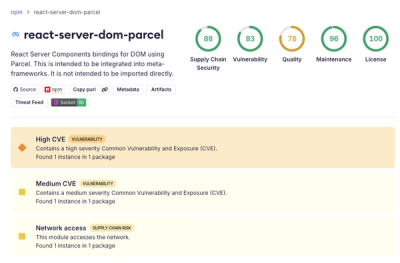
Security News
Deno 2.6 + Socket: Supply Chain Defense In Your CLI
Deno 2.6 introduces deno audit with a new --socket flag that plugs directly into Socket to bring supply chain security checks into the Deno CLI.
automation_model
Advanced tools
Affected versions:
An automation infrastructure module to be use for generative AI automation projects.
This API is built on top of Playwright to control browsers. The most common commands are:
clickclickTypeverifyTextExistInPagecucumber-js.Unless stated otherwise, the APIs will return an information object and will throw an error in case of failure.
async goto(url: string, world);
/* Use AI to identify an element and click on it */
async simpleClick(elementDescription, _params, options = {}, world);
async simpleClickType(elementDescription, value, _params, options = {}, world);
async click(selectors, _params, options = {}, world);
/* Return true/false */
async waitForElement(selectors, _params, options = {}, world);
async setCheck(selectors, checked = true, _params, options = {}, world);
async hover(selectors, _params, options = {}, world);
async selectOption(selectors, values, _params, options = {}, world);
async type(_value, _params, options = {}, world);
async setDateTime(selectors, value, format, enter = false, _params, options = {}, world);
/* Use to populate text fields */
async clickType(selectors, _value, enter = false, _params, options = {}, world);
/* Return the text */
async _getText(selectors, climb, _params, options = {}, info, world);
async containsText(selectors, text, climb, _params, options = {}, world);
setTestData(testData, world);
getTestData(world);
async verifyElementExistInPage(selectors, _params, options = {}, world);
async extractAttribute(selectors, attribute, variable, _params, options = {}, world);
async verifyAttribute(selectors, attribute, value, _params, options = {}, world);
async verifyPagePath(pathPart, options = {}, world);
async verifyTextExistInPage(text, options = {}, world);
async waitForTextToDisappear(text, options = {}, world);
async verifyTextRelatedToText(textAnchor, climb, textToVerify, options = {}, world);
async visualVerification(text, options = {}, world);
async waitForPageLoad(options = {}, world);
async closePage(options = {}, world);
saveTestDataAsGlobal(options, world);
async setViewportSize(width, height, options = {}, world);
async reloadPage(options = {}, world);
async conditionalWait(selectors, condition, timeout = 1000, _params = null, options = {}, world = null);
/* Return the ARIA snapshot as string */
async getAriaSnapshot();
async function login_with_user_and_password(_username, _password) {
const _params = { _username, _password };
// Fill Username textbox with "_username"
await context.web.clickType(elements["textbox_username"], _username, false, _params, null, this);
// Fill Password textbox with "_password"
await context.web.clickType(elements["textbox_password"], _password, false, _params, null, this);
// Click on Login button
await context.web.click(elements["button_login"], _params, null, this);
}
async function login_with_user_and_password(_username, _password) {
const _params = { _username, _password };
try {
await context.web.clickType(elements["textbox_username"], _username, false, _params, null, this);
await context.web.clickType(elements["textbox_password"], _password, false, _params, null, this);
await context.web.click(elements["button_login"], _params, null, this);
} catch (error) {}
}
async function login_with_user_and_password(_username, _password) {
const _params = { _username, _password };
if (await context.web.waitForElement(elements["textbox_username"], _params, { timeout: 4000 }, this)) {
await context.web.clickType(elements["textbox_username"], _username, false, _params, null, this);
await context.web.clickType(elements["textbox_password"], _password, false, _params, null, this);
await context.web.click(elements["button_login"], _params, null, this);
}
}
async function login_with_user_and_password(_username, _password) {
const _params = { _username, _password };
const maxRetry = 2;
for (let i = 0; i < maxRetry; i++) {
try {
await context.web.clickType(elements["textbox_username"], _username, false, _params, null, this);
await context.web.clickType(elements["textbox_password"], _password, false, _params, null, this);
await context.web.click(elements["button_login"], _params, null, this);
break;
} catch (error) {
if (i === maxRetry - 1) {
throw error;
}
}
}
}
async function login_with_user_and_password(_username, _password) {
const _params = { _username, _password };
await context.web.clickType(elements["textbox_username"], _username, false, _params, { timeout: 120000 }, this);
await context.web.clickType(elements["textbox_password"], _password, false, _params, { timeout: 120000 }, this);
await context.web.click(elements["button_login"], _params, { timeout: 120000 }, this);
}
To use the playwright page object directly, use: context.web.page
FAQs
An automation infrastructure module to be use for generative AI automation projects.
The npm package automation_model receives a total of 4,496 weekly downloads. As such, automation_model popularity was classified as popular.
We found that automation_model demonstrated a healthy version release cadence and project activity because the last version was released less than a year ago. It has 10 open source maintainers collaborating on the project.
Did you know?

Socket for GitHub automatically highlights issues in each pull request and monitors the health of all your open source dependencies. Discover the contents of your packages and block harmful activity before you install or update your dependencies.

Security News
Deno 2.6 introduces deno audit with a new --socket flag that plugs directly into Socket to bring supply chain security checks into the Deno CLI.

Security News
New DoS and source code exposure bugs in React Server Components and Next.js: what’s affected and how to update safely.

Security News
Socket CEO Feross Aboukhadijeh joins Software Engineering Daily to discuss modern software supply chain attacks and rising AI-driven security risks.